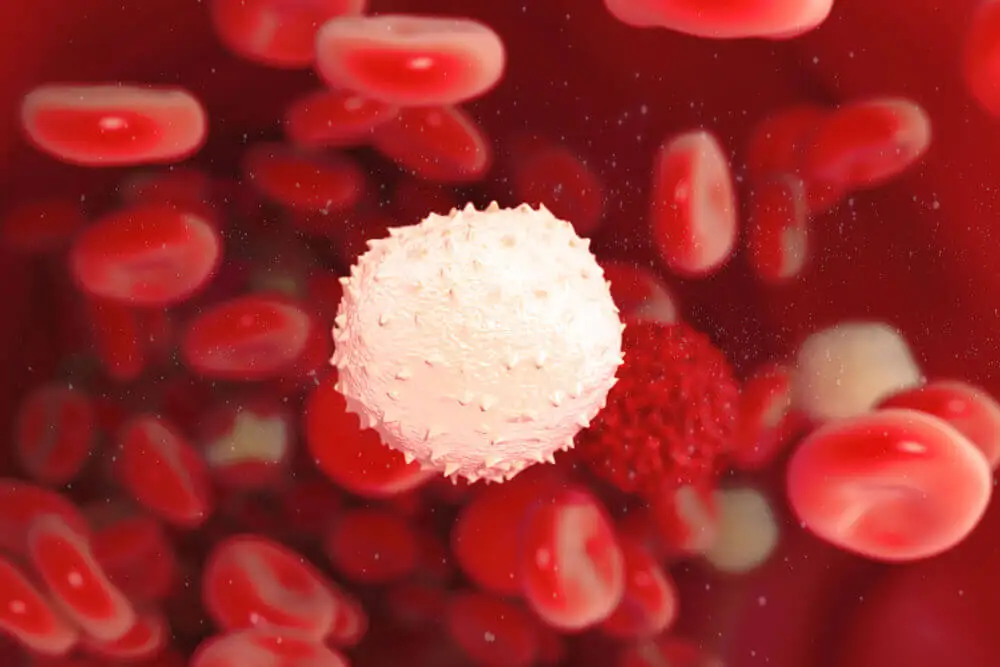What Are the Normal Values of Leukocytes?

The immune system is a complex network of cells and chemicals responsible for protecting the human body from germs and foreign bodies. Leukocytes are the most abundant immune cells in the body. Are you interested in knowing what they are and what the normal values of leukocytes are? We’ll tell you all about it in this article!
Leukocytes, or white blood cells, are a group of blood cells that actively participate in the innate and adaptive immune response of each person, according to different studies. They’re responsible for fighting infections and harmful substances, as well as eliminating abnormal cells of their own.
The levels of white blood cells in the blood are determined by a complete blood count or hematology. The percentage of leukocytes can increase or decrease in response to a wide range of diseases, making their determination indispensable for the diagnosis and early treatment of many conditions.
The characteristics and functions of leukocytes

White blood cells are produced in the bone marrow from hematopoietic stem cells. In general, leukocytes are found in the blood, lymphatic vessels, and in all tissues of the human body. Thus, they account for up to 1 % of the blood volume of an adult.
The so-called “white series” is able to move freely in the body and, unlike erythrocytes, lacks pigments. Some of the functions of leukocytes include the following:
- They recognize and differentiate harmful compounds.
- They combat bacterial, viral, parasitic, and fungal infections.
- Leukocytes mediate inflammatory responses.
- They modulate allergic reactions.
- They eliminate abnormal cells, such as cancer cells.
We think you may be interested in reading this, too: Aging of the Immune System and How to Fight It
Types of leukocytes
There are several types of leukocytes in the human body. These can be classified according to the shape of their nuclei and the presence or absence of granules in their cytoplasm. The type of leukocyte determines its specific functions within the immune system.
Those with granules and several nuclei are called granulocytes and include neutrophils, eosinophils, and basophils. On the other hand, those that don’t have granules and have a single nucleus are called agranulocytes and include lymphocytes and monocytes.
- Neutrophils constitute 50 to 70% of total leukocytes and form the first line of defense against bacteria and fungi, according to studies.
- Eosinophils actively participate against parasite infections and allergic reactions. They correspond to 2 to 3 % of the white series.
- Basophils release histamine and other substances that modulate the inflammatory response. They’re the least abundant leukocytes, constituting between 0.4 and 1 % of white blood cells.
- Monocytes travel in the blood to all tissues and differentiate into macrophages. They have a very short life span and form 5 to 6% of leukocytes.
- Lymphocytes: These white blood cells are common in blood and lymphoid organs. They represent approximately 30% of the white series and are responsible for recognizing harmful agents, releasing antibodies, and destroying damaged cells.
How are leukocytes measured in the blood?
Determining the levels of leukocytes in the blood is called a “white blood cell count.” This procedure makes it possible to identify the number of leukocytes from a venous blood sample. In addition, this test is part of blood biometry, one of the most common routine blood tests.
Similarly, the concentrations of neutrophils, eosinophils, basophils, monocytes and lymphocytes are also recognized from this test. These results are useful in assessing the state of the immune system and identifying underlying diseases, such as bacterial and viral infections.
Normal values
The white blood cell count can vary depending on the age, health status of the individual and the standardization of each laboratory. Studies state that normal white blood cell counts in adults are between 4,500 and 11,000 white blood cells per cubic millimeter of blood (mm³). During childhood, it’s possible to find the following normal ranges for leukocytes:
- Newborns: 10 000 – 30 000 white blood cells per mm³
- Under 1 year old: 6,000 – 18,000 white blood cells per mm³
- From 2 to 5 years: 6 000 – 15 000 white blood cells per mm³
- From 6 to 12 years: 5 000 – 13 000 white blood cells per mm³
Like this article? You may also like to read: Strengthen Your Immune System with 6 Habits
High leukocytes

An increase in blood leukocytes above 11 000 white blood cells per mm³ is called leukocytosis. This condition is often accompanied by an elevation of neutrophils or lymphocytes, called neutrophilia and lymphocytosis, respectively.
Leukocytosis is a sign of an underlying disease and often manifests with symptoms such as fever, swelling, shortness of breath, loss of appetite, dizziness and chills. Some of the most common causes of increased white blood cells include the following:
- Bacterial infections, such as pneumonia and meningitis
- Inflammatory processes, such as appendicitis, cholecystitis, and diverticulitis
- Deep and extensive burns
- Severe hemorrhages
- Traumatisms
- Stress
- Cancer, such as leukemia
- Inflammatory bowel disease (IBD)
- Severe parasitosis
- Allergic crises
- Medications, such as cortisone, adrenaline, and heparin
Low leukocytes
The Spanish Society of Internal Medicine (SEMI) defines leukopenia as a decrease in leukocytes below 4 000 white blood cells per mm³. People with a low white blood cell count may experience excessive fatigue, frequent infections, headache, and abdominal cramps. Among the most common causes are the following:
- Autoimmune diseases, such as lupus
- Bone marrow alterations due to tumors or intoxication
- Effect of chemotherapy and radiotherapy
- Use of antibiotics, anticonvulsants and corticosteroids
- Hepatic or renal disease
How to keep white blood cells normal
In most cases, white blood cell levels return to normal when the underlying cause is resolved. In this regard, it’s important to follow the doctor’s instructions in detail. Similarly, it’s possible to increase white blood cell counts by including some foods in our diet. Such is the case of the following foods:
- Black tea
- Yogurt
- Mushrooms, red bell peppers, and spinach
- Oysters and shellfish
- Red meat and liver
- Almonds, peanuts, and sunflower seeds
The most important immune cells in the human body
As you can see, leukocytes are the human body’s main source of defense against invading germs and foreign substances. In most cases, changes in white blood cell levels are a clear sign that something is wrong with the body. For this reason, it’s advisable to evaluate the state of your immune system annually with blood tests.
All cited sources were thoroughly reviewed by our team to ensure their quality, reliability, currency, and validity. The bibliography of this article was considered reliable and of academic or scientific accuracy.
- López, N., (2016). La biometría hemática. Acta pediátrica de México. 2016; 37(4): 246-249. https://www.scielo.org.mx/scielo.php?script=sci_arttext&pid=S0186-23912016000400246
- Barbieri, G., Flores, J., Vignoletti, F., (2005). El neutrófilo y su importancia en la enfermedad periodontal. Avances en Periodoncia. 2005; 17(1): 11-16. https://scielo.isciii.es/scielo.php?script=sci_arttext&pid=S1699-65852005000100002
- Becker, A., (2001). Interpretación del hemograma. Rev. chil. pediatr. 2001; 72( 5 ): 460-465. https://www.scielo.cl/scielo.php?script=sci_arttext&pid=S0370-41062001000500012
- TORRENS, M., (2015). INTERPRETACIÓN CLÍNICA DEL HEMOGRAMA. Revista Médica Clínica Las Condes. 2015;26(6):713-725.
- Herraiz-Raya L, Moreillo-Vicente L, Martínez-Ruiz J, Agustí-Martínez A, et al. Valor pronóstico del recuento de leucocitos y plaquetas, en tumores testiculares de células germinales. Actas Urológicas Españolas. 2019;43(6):284-292.
- Carrick JB, Begg AP. Peripheral blood leukocytes. Vet Clin North Am Equine Pract. 2008 Aug;24(2):239-59.
- Bermejo, L., Aparicio, L., López, A., & Ortega, R. (2021). Importancia de la nutrición en la defensa inmunitaria. Papel de la leche y sus componentes naturales. Nutrición Hospitalaria, 38(spe2), 17-22. https://scielo.isciii.es/scielo.php?script=sci_arttext&pid=S0212-16112021000500005#:~:text=En%20general%2C%20las%20dietas%20deben,tambi%C3%A9n%20en%20numerosos%20compuestos%20antioxidantes.
- Becker K., A. (2001). Interpretación del hemograma. Revista chilena de pediatría, 72(5), 460-465. https://dx.doi.org/10.4067/S0370-41062001000500012
- Kennelly, P., & Murray, R. Leucocitos. Harper, Bioquímica ilustrada 30e, capítulo 54. Access Medicina. https://accessmedicina.mhmedical.com/content.aspx?bookid=1814§ionid=127366549
- Arispe, M., Et al., (2019). Importancia del examen general de orina, en el diagnóstico preliminar de patologías de vías urinarias renales y sistémicas, en mujeres aparentemente sanas. Revista CON-CIENCIA, 7(1), 93-102. http://www.scielo.org.bo/scielo.php?script=sci_arttext&pid=S2310-02652019000100009&lng=es&tlng=es.
- SEMI. (S.F). LEUCOPENIA. Consultado el 12 de febrero de 2023. https://www.fesemi.org/informacion-pacientes/conozca-mejor-su-enfermedad/leucopenia
This text is provided for informational purposes only and does not replace consultation with a professional. If in doubt, consult your specialist.








